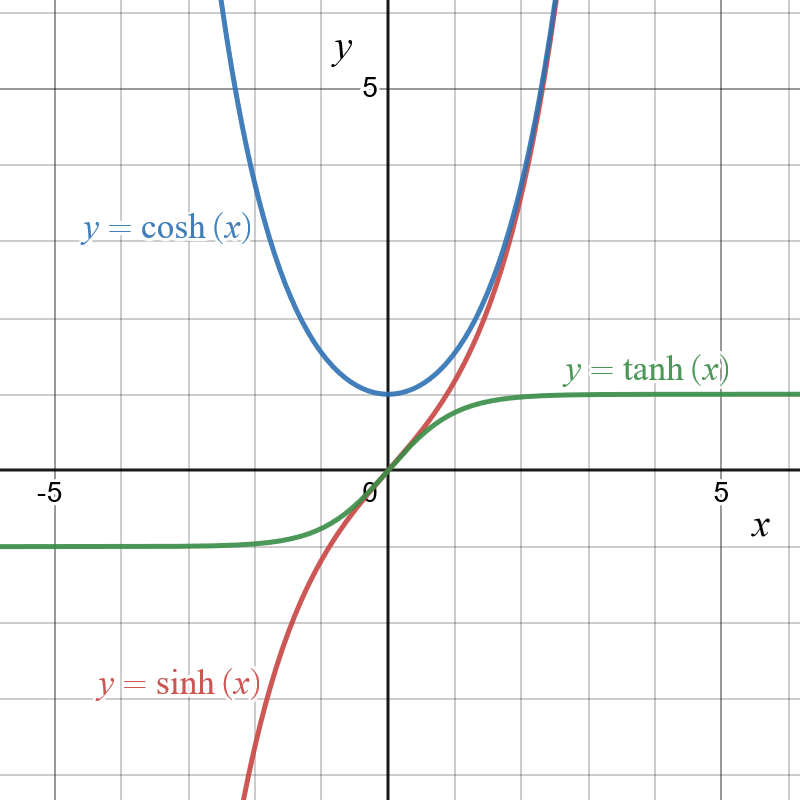HF1 Hyperbolic functions

Image from Pixabay
The hyperbolic functions are analogous to the circular (trigonometric) functions and are widely used in engineering, science and mathematics. Whereas circular functions are defined on a unit circle, the hyperbolic functions are defined on a hyperbola.
Hyperbolic functions are used to describe a cable or chain that is suspended at its end points. For example, these functions can be used to describe the curve adopted by electrical supply lines.
This module introduces hyperbolic functions, their graphs and similarities to the circular functions.
Definitions
The basic hyperbolic functions are sinh and cosh.
The hyperbolic sine function is
\[\begin{align*} \sinh\left(x\right) & =\frac{e^{x}-e^{-x}}{2}. \end{align*}\] This is pronounced as “shine \(x\)”.
The hyperbolic cosine function is defined as \[\begin{align*} \cosh\left(x\right) & =\frac{e^{x}+e^{-x}}{2}. \end{align*}\] This is pronounced as “cosh \(x\)”.
In addition to these we also define: \[\begin{align*} \tanh\left(x\right) & =\frac{\sinh\left(x\right)}{\cosh\left(x\right)}\\ & =\frac{e^{x}-e^{-x}}{e^{x}+e^{-x}}. \end{align*}\] This is pronounced as “than \(x\)” where the “than” is pronounced as in “thank”.
Just as for the circular functions, there are reciprocal hyperbolic functions. They are:
\[\begin{align*} \text{$\text{coshec$\left(x\right)$ }$ } & =\frac{1}{\sinh\left(x\right)}\\ \text{sech$\left(x\right)$ } & =\frac{1}{\cosh\left(x\right)}\\ \coth\left(x\right) & =\frac{1}{\tanh\left(x\right)}. \end{align*}\]
Example 1
What is the exact value of \(\sinh\left(0\right)?\)
Solution:
By definition, \[\begin{align*} \sinh\left(0\right) & =\frac{e^{0}-e^{-0}}{2}\\ & =\frac{1-1}{2}\\ & =0. \end{align*}\]
Hence the value of \(\sinh\left(0\right)=0.\)
Example 2
What is the exact value of \(\cosh\left(\ln\left(2\right)\right)\)?
Solution:
By definition, \[\begin{align*} \cosh\left(\ln\left(2\right)\right) & =\frac{1}{2}\left(e^{\ln\left(2\right)}+e^{-\ln\left(2\right)}\right)\\ & =\frac{1}{2}\left(e^{\ln\left(2\right)}+e^{\ln\left(2^{-1}\right)}\right)\\ & =\frac{1}{2}\left(e^{\ln\left(2\right)}+e^{\ln\left(\frac{1}{2}\right)}\right)\\ & =\frac{1}{2}\left(2+\frac{1}{2}\right)\\ & =\frac{1}{2}\cdot\frac{5}{2}\\ & =\frac{5}{4}. \end{align*}\]
Hence \(\cosh\left(\ln\left(2\right)\right)=5/4.\)
Example 3
Solve for \(x,\) \(\sinh\left(x\right)=3/4\).
Solution:
Using the definition of \(\sinh,\) \[\begin{align*} \frac{1}{2}\left(e^{x}-e^{-x}\right) & =\frac{3}{4}\\ e^{x}-e^{-x} & =\frac{3}{2}. \end{align*}\] Multiplying both sides by \(2e^{x}\) and rearranging, \[\begin{align*} 2e^{2x}-2 & =3e^{x}\\ 2e^{2x}-3e^{x}-2 & =0\\ 2\left(e^{x}\right)^{2}-3e^{x}-2 & =0, \end{align*}\] which is a quadratic in \(e^{x}.\) Using the quadratic formula1 For a quadratic \[\begin{align*} ax^{2}+bx+c & =0 \end{align*}\] where \(a,\) \(b\) and \(c\) are constants, \[\begin{align*} x & =\frac{-b\pm\sqrt{b^{2}-4ac}}{2a}. \end{align*}\] \[\begin{align*} e^{x} & =\frac{3\pm\sqrt{\left(-3\right)^{2}-4\left(2\right)\left(-2\right)}}{2\left(2\right)}\\ & =\frac{3\pm\sqrt{9+16}}{4}\\ & =\frac{3\pm5}{4}. \end{align*}\] Since \(e^{x}>0\) for all \(x,\) we ignore the negative sign and \[\begin{align*} e^{x} & =\frac{3+5}{4}\\ & =2. \end{align*}\] Taking logs of both sides gives \(x=\ln\left(2\right).\) Hence, the required value of \(x=\ln\left(2\right).\)
Graphs of Hyperbolic Functions
The graphs of \(\sinh\left(x\right),\) \(\cosh\left(x\right)\) and \(\tanh\left(x\right)\) are shown below in red, blue and green respectively.

The domain for each function is \(\mathbb{R}\). The range of \(\sinh\) is \(\mathbb{R}\) while the range of \(\cosh\) is \(\left[\left.1,\infty\right)\right..\) The graph of \(\tanh\left(x\right)\) has asymptotes at \(y=\pm1\) so \(\tanh\) has range \(\left(-1,1\right).\)
Note that \[\begin{align*} \sinh\left(-x\right) & =-\sinh\left(x\right)\\ \cosh\left(-x\right) & =\cosh\left(x\right), \end{align*}\] that is, the functions \(\sinh\) and \(\cosh\) are odd and even functions, respectively.
Note also that the function \(\cosh\left(x\right)\) is not one to one.
Hyperbolic Identities
The hyperbolic functions have identities that are similar, though not the same, as circular functions.
The most important are: \[\begin{align*} \cosh^{2}\left(x\right)-\sinh^{2}\left(x\right) & =1\\ 1-\tanh^{2}\left(x\right) & =\text{sech$^{2}\left(x\right)$ }\\ \sinh\left(x+y\right) & =\sinh\left(x\right)\cosh\left(y\right)+\cosh\left(x\right)\sinh\left(y\right)\\ \cosh\left(x+y\right) & =\cosh\left(x\right)\cosh\left(y\right)+\sinh\left(x\right)\sinh\left(y\right)\\ \sinh\left(2x\right) & =2\sinh\left(x\right)\cosh\left(x\right). \end{align*}\] Note that these are similar to the trigonometric identities: \[\begin{align*} \cos^{2}\left(x\right)+\sin^{2}\left(x\right) & =1\\ 1+\tan^{2}\left(x\right) & =\text{$\sec^{2}$ $\left(x\right)$ }\\ \sin\left(x+y\right) & =\sin\left(x\right)\cos\left(y\right)+\cos\left(x\right)\sin\left(y\right)\\ \cos\left(x+y\right) & =\cos\left(x\right)\cos\left(y\right)-\sin\left(x\right)\sin\left(y\right)\\ \sin\left(2x\right) & =2\sin\left(x\right)\cos\left(x\right). \end{align*}\] Other identities may be derived from these. For example, \[\begin{align*} \cosh\left(2x\right) & =\cosh\left(x+x\right)\\ & =\cosh\left(x\right)\cosh\left(x\right)+\sinh\left(x\right)\sinh\left(x\right)\\ & =\cosh^{2}\left(x\right)+\sinh^{2}\left(x\right)\\ & =1+\sinh^{2}\left(x\right)+\sinh^{2}\left(x\right)\\ & =1+2\sinh^{2}\left(x\right). \end{align*}\]
Example 4
If \(\sinh\left(x\right)=3/5,\) what is the value of \(\cosh\left(x\right)?\)
Solution:
Using the identity \[\begin{align*} \cosh^{2}\left(x\right)-\sinh^{2}\left(x\right) & =1 \end{align*}\] we have \[\begin{align*} \cosh^{2}\left(x\right) & =1+\sinh^{2}\left(x\right)\\ & =1+\left(\frac{3}{5}\right)^{2}\\ & =\frac{34}{25}\\ \cosh\left(x\right) & =\pm\sqrt{\frac{34}{25}}\\ & =\frac{\sqrt{34}}{5}. \end{align*}\] Note that we reject \(-\sqrt{34}/5\) as the range of \(\cosh\) is \(\left[\left.1,\infty\right)\right..\)
Example 5
If \(\cosh\left(x\right)=5/3,\) what is the value of \(\sinh\left(x\right)\)?
Solution:
Using the identity \[\begin{align*} \cosh^{2}\left(x\right)-\sinh^{2}\left(x\right) & =1 \end{align*}\] we have \[\begin{align*} \sinh^{2}\left(x\right) & =\cosh^{2}\left(x\right)-1\\ & =\left(\frac{5}{3}\right)^{2}-1\\ & =\frac{25}{9}-1\\ & =\frac{16}{9}\\ \sinh\left(x\right) & =\pm\sqrt{\frac{16}{9}}\\ & =\pm\frac{4}{3}. \end{align*}\] Note that there are two solutions in this case because the range of \(\sinh\) is \(\left(-\infty,\infty\right)\) and \(\cosh\left(x\right)\) is not one to one.
Example 6
If \(\sinh\left(x\right)=3/4,\) what is the exact value of \(x?\)
Solution:
From the definition of \(\sinh\left(x\right)\) \[\begin{align*} \frac{3}{4} & =\frac{1}{2}\left(e^{x}-e^{-x}\right). \end{align*}\] Multiplying both sides by 4 and rearranging, \[\begin{align*} 2e^{x}-3-2e^{-x} & =0. \end{align*}\] Multiplying both sides2 No problems arise from this as \(e^{x}>0\) for all \(x.\) by \(e^{x},\) \[\begin{align*} 2e^{2x}-3e^{x}-2 & =0. \end{align*}\] This is a quadratic in \(e^{x}\) and may be factorised to give \[\begin{align*} \left(2e^{x}+1\right)\left(e^{x}-2\right) & =0. \end{align*}\] The first bracket is never zero as \(e^{x}>0\) for all \(x.\) Hence \[\begin{align*} e^{x}-2 & =0\\ e^{x} & =2\\ x & =\ln\left(2\right). \end{align*}\]
The value of \(x\) is \(\ln\left(2\right).\)
Example 7
Show that \(\sinh\left(2x\right)=2\sinh\left(x\right)\cosh\left(x\right).\)
Solution:
In this solution, we use the difference of two squares formula3 Difference of two squares formula is \[\begin{align*} a^{2}-b^{2} & =\left(a-b\right)\left(a+b\right). \end{align*}\]. Using the definition of \(\sinh,\) the left hand side may be written as \[\begin{align*} \sinh\left(2x\right) & =\frac{1}{2}\left(e^{2x}-e^{-2x}\right)\\ & =\frac{1}{2}\left(\left(e^{x}\right)^{2}-\left(e^{-x}\right)^{2}\right)\\ & =\frac{1}{2}\left(e^{x}-e^{-x}\right)\left(e^{x}+e^{-x}\right)\\ & =\sinh\left(x\right)\left(e^{x}+e^{-x}\right)\\ & =2\sinh\left(x\right)\frac{\left(e^{x}+e^{-x}\right)}{2}\\ & =2\sinh\left(x\right)\cosh\left(x\right) \end{align*}\] as required.
Example 8
Given that \(\tanh\left(x\right)=4/5,\) find the value of all the other hyperbolic functions: \(\sinh,\) \(\cosh,\) \(\ \text{sech, coshec and coth.}\)
Solution:
Using the identity \(1-\tanh^{2}\left(x\right)=\text{sech$^{2}\left(x\right)$ }\), \[\begin{align*} \text{sech$\left(x\right)$ } & =\sqrt{1-\left(\frac{4}{5}\right)^{2}}\\ & =\sqrt{\frac{9}{25}}\\ & =\frac{3}{5} \end{align*}\] and \[\begin{align*} \cosh\left(x\right) & =\frac{5}{3}. \end{align*}\]
Using the identity \(\cosh^{2}\left(x\right)-\sinh^{2}\left(x\right)=1\), \[\begin{align*} \sinh\left(x\right) & =\sqrt{\left(\frac{5}{3}\right)^{2}-1}\\ & =\sqrt{\frac{16}{9}}\\ & =\frac{4}{3} \end{align*}\] and \[\begin{align*} \text{cosech$\left(x\right)$ } & =\frac{3}{4}. \end{align*}\]
Note that we could also use \[\begin{align*} \tanh\left(x\right) & =\frac{\sinh\left(x\right)}{\cosh\left(x\right)}\\ \sinh\left(x\right) & =\tanh\left(x\right)\cosh\left(x\right)\\ & =\frac{4}{5}\times\frac{5}{3}\\ & =\frac{4}{3} \end{align*}\] to get \(\sinh\left(x\right)\) and hence cosech\(\left(x\right).\)
Finally, given that \(\tanh\left(x\right)=4/5\), \[\begin{align*} \text{coth$\left(x\right)$ } & =\frac{5}{4}. \end{align*}\]
Exercises
\(1\). Simplify
\(\quad\)a) \(2\cosh\left(\ln\left(x\right)\right)\)
\(\quad\)b) \(\sinh\left(2\ln\left(x\right)\right)\).
\(2\). Using the definitions of \(\cosh\) and \(\sinh,\) in terms of exponential functions, show that \[\begin{align*} \cosh^{2}\left(x\right)-\sinh^{2}\left(x\right) & =1. \end{align*}\]
\(3\). If \(\sinh\left(x\right)=3/4,\) what is the value of \(\tanh\left(x\right)\)?
Answers
- \(x+\frac{1}{x}\qquad\)b) \(\frac{1}{2}\left(x^{2}-\frac{1}{x^{2}}\right)\)
- \(\tanh\left(x\right)=\frac{3}{5}\).
Download this page: HF1 Hyperbolic Functions (PDF 548KB)
What's next... HF2 Derivatives and integrals of hyperbolic functions
